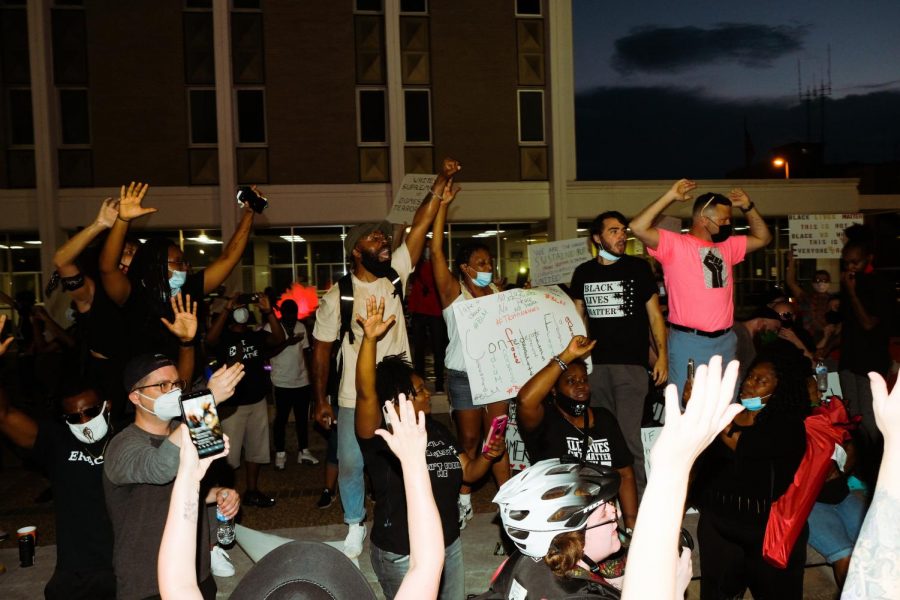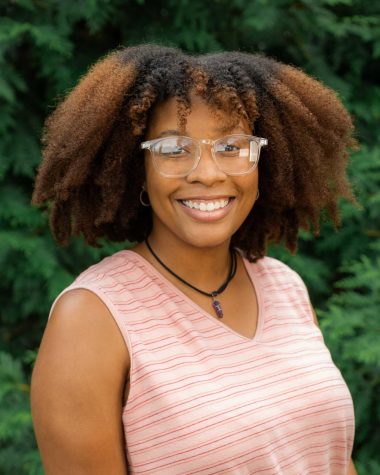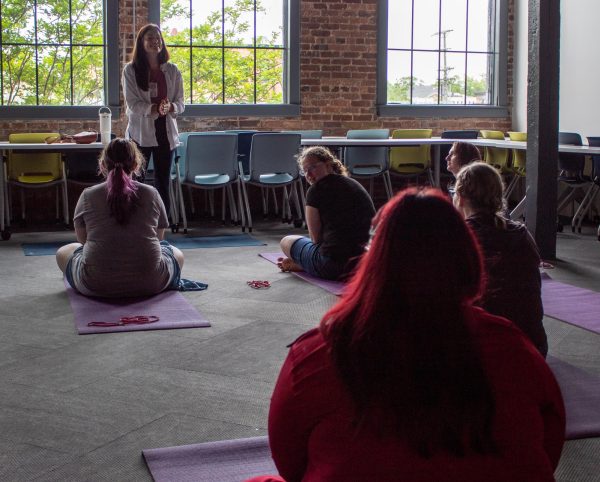Project Say Something refuses to give up fight for statue removal
Anay Rojra | Chief Photographer
The non-profit, racial injustice group hosts monument removal events five days out of the week. These events typically only last an hour, depending on the turnout.
August 20, 2020
Project Say Something, a Shoals racial injustice group, continues to call for the confederate statue in front of Florence Courthouse to be relocated to the Soldier’s Rest Cemetery.
“That’s a more appropriate place,” said Camille Bennett, founder of Project Say Something. “It’s offensive and dehumanizing. It stands in front of a space that’s supposed to represent justice.”
Bennett founded Project Say Something in 2014 when members at her spiritual center, Living Spirit Church, asked if she could open up the space to talk about racism.
“It wasn’t anything that I was planning to do,” Bennett said. “At the time, I had been studying Black History for about a year and was really diving into it, but was in no way prepared to facilitate or lead any kind of movement. I opened up the space and we just had a really big turn out so I was able to identify that people wanted to have [those] more in-depth conversations.”
Bennett said that Project Say Something grew organically from there. Before she knew it, they were filming a video and then, within six months, they were taking action in multiple ways.
According to their Facebook page, Project Say Something’s mission is to confront racial injustice through Black history by using communication, education and community empowerment to reconcile the past with the present.
Removing confederate statues is not the only project they are actively working on. The organization also has a Shoals Black History Initiative, where they gather local black history to teach in schools, and anti-racism training. But, their protest of confederate statues seems to be one of their biggest projects yet.
“We have already been challenging confederate monuments, already doing the work for three years prior,” Bennett said. “[Only now,] we’re just kind of breaking ice, breaking grounds and starting to be more expansive as a movement.”
Witnessing the death of George Floyd only further pushed Project Say Something’s initiative to have confederate statues removed.
“George Floyd happened and we, like the rest of the world, [were] heart broken,” Bennett said. “Beyond that, we are just fed up, tired and impatient. [Floyd’s death] brought about this intolerance of overt racism, so you saw this reaction from people around the world where people were just like: ‘In this moment, what can I touch that’s just really racist that I’m not going to look at this anymore?’ and confederate monuments was one of them.”
Project Say Something hosts their monument removal events five days of the week, where they typically last an hour. But, these are not just any ordinary protests. While some protests involve marching and chanting, they can vary from dance protests to vehicle parades.
“It’s to give us range, to give us longevity because if we’re protesting five days a week doing the exact same thing every single day, the burn out factor would increase tenfold,” Bennett said. “If you are taking the opportunity to be creative, you are energized and you have the momentum to keep going.”
Bennett said in doing this, she does believe that Project Say Something is generating change in the Shoals.
“We are definitely effective,” Bennett said. “As we’re advocating for the removal of the monument, not only are we giving rural communities a voice, but we also started a whole other movement of counterprotesters. Some of [the counterprotesters] who have been involved have businesses, are dentists, we’ve [even] had a few teachers. All these community members that are literally saying: ‘we have a problem with a black lives matter movement’ and in doing this, their racism is exposed.”
Bennett said that people are trying to defend the statue because they have been given permission to believe misinformation because President Donald Trump will say that a fact is not a fact.
To these people, Bennett encourages them to go to Florence-Lauderdale Public Library and read the dedication speech that was given when the monument was erected in 1903.
“Their civilization differs from ours in one essential that creates an impassable barrier,” said Dr. H.A. Moody, a confederate veteran in his dedication speech. “They look upon a Negro as a white man with a colored skin and believe education to be the one thing needful. We of the south know better. No other people know him so well or love him so well, but nowhere here is he accorded social equality. When the highest representative of Northern civilization invites the highest representative of negro civilization to sit at his table as his social equal, he digs a gulf between us too wide and deep for us to go to them or for them to come to us.
“Into the form of man God breathed the breath of eternal life and he became a living soul, so separate from the manlike forms around them that when the children of Adam, sons of God by virtue of that miraculous inspiration, saw that the daughters of men were fair and married them, he sent a deluge that destroyed the mongrel race.”
When Bennett read it for the first time, it lit a fire inside of her – one that she wishes others would feel too.
“[Counterprotesters] don’t fully understand why we’re protesting,” Bennett said. “The only thing they do understand is the narrative they’ve been told, which is a false narrative.”
Project Say Something has spoken to local officials in hopes that finding the statue’s speech would help the removal of the monument, but instead Bennett said she has only got “a bunch of finger pointing.”
“The county commissioners who were supposed to be key decision makers were problematic to say the least,” Bennett said. “The way they responded to our request lacked integrity, and really put them on the side of the counterprotesters in my opinion. They wouldn’t even put our issue on their agenda.”
Bennett said that Project Say Something discovered that the county commissioners only owned the property itself, whereas it was the City of Florence who owned the confederate statue.
“The city of Florence was actually in favor of the removal and relocation,” Bennett said. “We had an anonymous donor come up with the money so if there was a fine and subsequent damages, that would have been paid. But then, Florence started to say, ‘We need the county to come up with a legal document saying that they can come on their property and get the statue.’”
Bennett admitted that she was upset, but she was mostly disappointed that no one has spoken to the moral issue.
“No one has talked about why it’s important to remove this statue,” Bennett said. “None of them have spoken to the dedication speech. None of them have done what I think an appropriate leader would do in this moment based on the civil unrest we’ve seen in our community.”
Despite all of the odds being against them, Project Say Something refuses to give up.
“[Our next steps] are to continue to support our movement, to agitate the status quo and to shine a light on racial injustice in our community until our demands are met,” Bennett said.
Being in the position that she is in, Bennett has nasty comments directed specifically towards her on Facebook but they are nothing compared to the death threats she received.
“I report it to our local law enforcement,” Bennett said. “Internally, I try my best not to focus on them. I’ve kind of just become immune to it where I’m just like: ‘I heard this before.’”
But, Bennett does not think that she will ever see the world the same again.
“I think that people can read about death threats and see them on TV, but there’s nothing quite like them happening to you specifically because you are black and speaking out about racism,” Bennett said. “I’m criminalized. I’ve been called a terrorist, a Marxist and everything there is. [In experiencing this,] you see the world differently, you see racism differently, and you see how toxic it can be.”
Bennett said in her darkest hour, she reflects on Diane Nash with the Freedom Riders, who was 20 years younger than her with worse threats. Or, she thinks of the Children’s March of Birmingham, where they took to the streets with dogs and hoses.
“[Diane Nash and the Children’s March of Birmingham] did all of that so it could be easier for us now,” Bennett said.
Bennett remains confident in how far Project Say Something and the Black Lives Matter movement have come and in where they are going.
“I [would have] never thought that we would come this far or that we would make way from such a tiny space in the world,” Bennett said. “I have a whole new perspective on what can be done with a very small amount of people and resources, the impact that you can have if you choose to never give up.”












